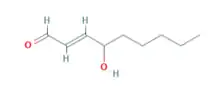Reactive aldehyde species
Reactive aldehyde species (RASP), also known as reactive aldehydes, refer to a class of electrophilic organic aldehyde molecules that are generally toxic or facilitate inflammation. RASP covalently react with amine groups (via Schiff base formation) and thiol groups (via Michael addition), particularly in proteins.[1] Following threshold amounts of binding to the electrophile-responsive proteome, RASP modify protein function,[2] as has been described with MAP kinase, protein kinase C, and other proteins that potentiate cytokine release and other aspects of inflammation.[3] Binding of RASP to proteins can also lead to NF-kB activation,[4] autoantibody formation[5] and activation of Scavenger Receptor A.[6] RASP are formed via a variety of processes, including oxidation of alcohols,[7] polyamine metabolism [8] and lipid peroxidation.[1] In addition to binding to proteins and other amine or thiol-containing molecules such as glutathione, RASP are metabolized by aldehyde dehydrogenases[7] or aldehyde reductases.[8] Due to the toxicity of RASP, only a small number of genetic mutations in aldehyde dehydrogenases allow for viable offspring, resulting in Sjögren-Larsson Syndrome[7] and other rare diseases.

The two most commonly reported disease-associated pro-inflammatory RASP are malondialdehyde and 4-hydroxynonenal,[9] although many others, including acrolein, crotonaldehyde, acetaldehyde, and hexanal, have been described.[1] The toxicity of RASP include mutagenicity, aggregate formation, and generalized cytotoxicity.[1][10]
In a Phase 2 clinical trials, the RASP inhibitor reproxalap was shown to mitigate inflammation in patients with noninfectious anterior uveitis[11] and dry eye disease.[12]
References
- Esterbauer, H.; Schaur, R. J.; Zollner, H. (1991). "Chemistry and biochemistry of 4-hydroxynonenal, malonaldehyde and related aldehydes". Free Radical Biology & Medicine. 11 (1): 81–128. doi:10.1016/0891-5849(91)90192-6. ISSN 0891-5849. PMID 1937131.
- Higdon, Ashlee; Diers, Anne R.; Oh, Joo Yeun; Landar, Aimee; Darley-Usmar, Victor M. (2012-03-15). "Cell signalling by reactive lipid species: new concepts and molecular mechanisms". The Biochemical Journal. 442 (3): 453–464. doi:10.1042/BJ20111752. ISSN 1470-8728. PMC 3286857. PMID 22364280.
- Raghavan, Somasundaram; Subramaniyam, Ganesan; Shanmugam, Narkunaraja (2012). "Proinflammatory effects of malondialdehyde in lymphocytes". Journal of Leukocyte Biology. 92 (5): 1055–1067. doi:10.1189/jlb.1211617. ISSN 1938-3673. PMID 22956781. S2CID 5472211.
- Kalariya, Nilesh M.; Ramana, Kota V.; Srivastava, Satish K.; van Kuijk, Frederik J. G. M. (2008). "Carotenoid derived aldehydes-induced oxidative stress causes apoptotic cell death in human retinal pigment epithelial cells". Experimental Eye Research. 86 (1): 70–80. doi:10.1016/j.exer.2007.09.010. ISSN 0014-4835. PMC 2786271. PMID 17977529.
- Thiele, Geoffrey M.; Duryee, Michael J.; Anderson, Daniel R.; Klassen, Lynell W.; Mohring, Stephen M.; Young, Kathleen A.; Benissan-Messan, Dathe; Sayles, Harlan; Dusad, Anand; Hunter, Carlos D.; Sokolove, Jeremy (March 2015). "Malondialdehyde-acetaldehyde adducts and anti-malondialdehyde-acetaldehyde antibodies in rheumatoid arthritis". Arthritis & Rheumatology (Hoboken, N.J.). 67 (3): 645–655. doi:10.1002/art.38969. ISSN 2326-5205. PMC 5469548. PMID 25417811.
- Sapkota, Muna; DeVasure, Jane M.; Kharbanda, Kusum K.; Wyatt, Todd A. (2017). "Malondialdehyde-acetaldehyde (MAA) adducted surfactant protein induced lung inflammation is mediated through scavenger receptor a (SR-A1)". Respiratory Research. 18 (1): 36. doi:10.1186/s12931-017-0517-x. ISSN 1465-993X. PMC 5307820. PMID 28193223.
- Rizzo, William B. (March 2014). "Fatty aldehyde and fatty alcohol metabolism: review and importance for epidermal structure and function". Biochimica et Biophysica Acta (BBA) - Molecular and Cell Biology of Lipids. 1841 (3): 377–389. doi:10.1016/j.bbalip.2013.09.001. ISSN 0006-3002. PMC 3993971. PMID 24036493.
- Wood, Paul L.; Khan, M. Amin; Moskal, Joseph R. (2007-05-11). "The concept of "aldehyde load" in neurodegenerative mechanisms: cytotoxicity of the polyamine degradation products hydrogen peroxide, acrolein, 3-aminopropanal, 3-acetamidopropanal and 4-aminobutanal in a retinal ganglion cell line". Brain Research. 1145: 150–156. doi:10.1016/j.brainres.2006.10.004. ISSN 0006-8993. PMID 17362887. S2CID 1228632.
- Fritz, Kristofer S.; Petersen, Dennis R. (2013-06-01). "An overview of the chemistry and biology of reactive aldehydes". Free Radical Biology and Medicine. Methods in Lipid Oxidation. 59: 85–91. doi:10.1016/j.freeradbiomed.2012.06.025. ISSN 0891-5849. PMC 3540155. PMID 22750507.
- Marchitti, Satori A.; Chen, Ying; Thompson, David C.; Vasiliou, Vasilis (July 2011). "Ultraviolet Radiation: Cellular Antioxidant Response and the Role of Ocular Aldehyde Dehydrogenase Enzymes". Eye & Contact Lens. 37 (4): 206–213. doi:10.1097/ICL.0b013e3182212642. ISSN 1542-2321. PMC 3356694. PMID 21670692.
- Mandell, Kenneth J.; Clark, David; Chu, David S.; Foster, C. Stephen; Sheppard, John; Brady, Todd C. (December 2020). "Randomized Phase 2 Trial of Reproxalap, a Novel Reactive Aldehyde Species Inhibitor, in Patients with Noninfectious Anterior Uveitis: Model for Corticosteroid Replacement". Journal of Ocular Pharmacology and Therapeutics. 36 (10): 732–739. doi:10.1089/jop.2020.0056. ISSN 1557-7732. PMC 7757619. PMID 32955967.
- Clark, David; Sheppard, John; Brady, Todd C. (2021-01-15). "A Randomized Double-Masked Phase 2a Trial to Evaluate Activity and Safety of Topical Ocular Reproxalap, a Novel RASP Inhibitor, in Dry Eye Disease". Journal of Ocular Pharmacology and Therapeutics. doi:10.1089/jop.2020.0087. ISSN 1080-7683.